Some crimes are so terrible, an affront to humanity, that they are impossible to capture in a memorial. But it could be said that memorials are for the living, not for the dead, a way to comfort the survivors, a way to redeem the suffering through beauty, and a reminder that we have to care for the hungry citizens in the world today.
New York
Thousands suffering in Ireland made the journey across the Atlantic to America, and for those who landed in New York, that southern tip of Manhattan was among their first sights to behold upon arrival. From the western end of the Memorial, visitors climb the man-made hill to its peak 25 feet above the Battery Park City sidewalks below and are treated to a view of Ellis Island and the Statue of Liberty, appropriate given their emblematic significance to the American immigration story.
The Irish Hunger Memorial contains stones from each of the 32 counties of Ireland in its half-acre.
Designed by artist Brian Tolle, the eastern end of the Memorial is a sloping path that coaxes visitors to follow to the ruined roofless cottage. The cottage, an authentic ruin brought from County Mayo, is a tribute to those who chose to abandon their homes in an effort to survive.
Along the base of the elevated Memorial and through the center passage way are bands of texts separated by layers limestone. The limestone, imported from Kilkenny is more than 300 million years old, containing fossils from the Irish seabed. The text, nearly two miles long, tells the history of the Irish Famine. Illuminated by backlight, the text consists of quotations from autobiographies, letters, oral traditions, songs, reports, poems, recipes and statistics that pertain not only to the Irish Famine but also chronicle epidemics of hunger throughout the world.
Manhattan is also home to a sculpture designed by John Behan titled “Arrival,” which was given to the United Nations by the Irish government. The sculpture depicts a ghostly coffin ship and was unveiled in November 2000. A similar sculpture entitled “Coffin Ship” by the same artist was erected at the foot of Croagh Patrick in County Mayo in 1997.
The Western New York Irish Famine Memorial is located in Buffalo, New York with views of the Old Eerie Canal. Dedicated in 1997, the memorial is flanked by 32 boulders, one for each Irish county that form the outer ring, and standing off center is a massive granite standing stone from Carraroe, County Galway. Its position represents the Irish Diaspora and it stands surrounded by inscriptions of names of famine victims.

Massachusetts
Boston is home to two very different structures which honor the memories of the famine victims who flooded into the New England harbors in the 19th century. The Boston Famine Memorial located along the famous Freedom Trail in downtown Boston at the corner of Washington and School Streets, features sculptures of a family of immigrants arriving in the Boston and another leaving the shores of Ireland. The figures, with torn clothes and sunken faces allow visitors a glimpse into artist Robert Shure’s vision of the complexity of that impoverished struggle combined with the determination for a better life.
The second memorial is a peninsula in Boston Harbor known as Deer Island which paints a more somber picture of famine victims. In 1847 Deer Island was the site of a Quarantine hospital and later in 1850 an almshouse was built. Many famine victims tragically died there after their long journeys. The Rest Haven Cemetery here contains graves of hundreds Irish who didn’t make it.
The Irish Famine Monument in Cambridge depicts the separation of families, showing a mother seated holding a small child and the father feet away holding another child. Each reaches out to the other on a stone platform on which is inscribed the phrase, “Never again should a people starve in a world of plenty.” The monument, located in the heart of the Cambridge Commons, just west of Harvard University was designed by Maurice Harrow and Derry Ireland, was dedicated by President Mary Robinson in July of 1997.
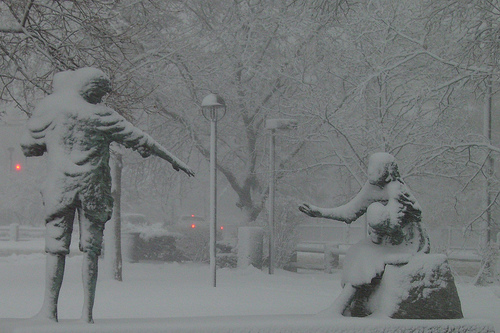
Illinois
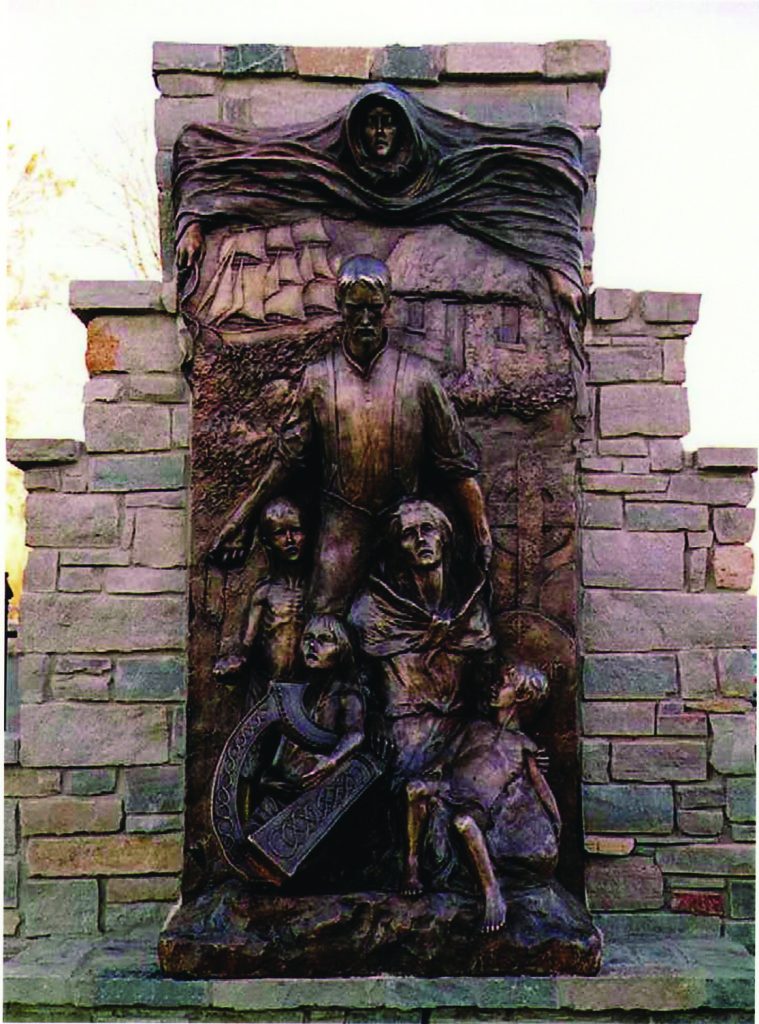
In Chicago’s Gaelic Park, the Irish Famine Memorial Monument stands nearby the park’s main building. Commissioned and paid for by Gaelic Park the giant statue depicts an Irish family, their home from which they have been evicted burning behind them. Headstones are also featured in the background, emblematic of those whose lives were lost. On the opposite side of their burning home is an infamous “coffin ship,” the option many took to sail away from their homeland to North America, hundreds of whom eventually settled in Chicago. The memorial monument was designed by Fr. Anthony Brankin, a local Chicago parish pastor.
Ohio
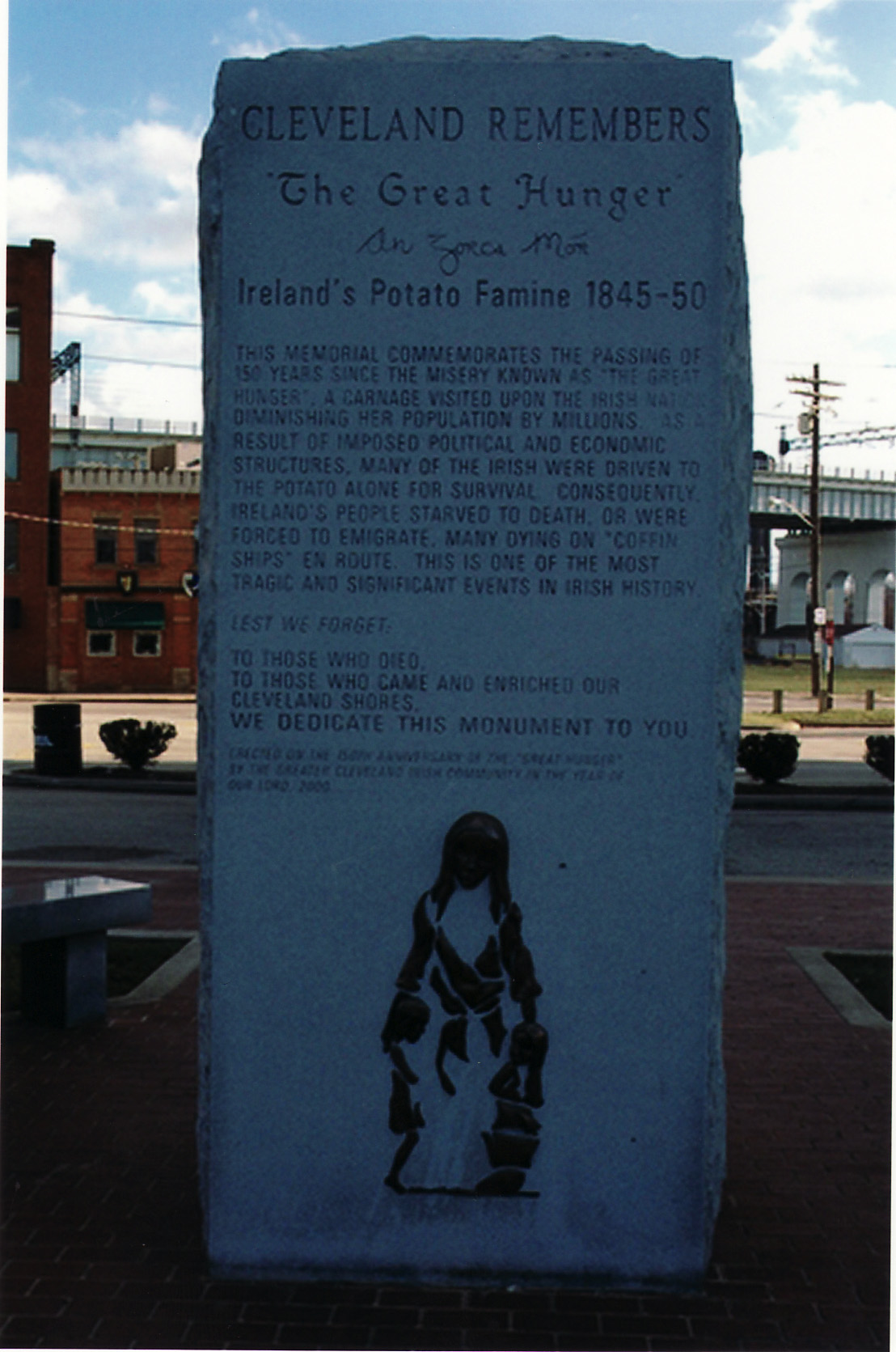
Commemorating the 150-year anniversary of the famine, a monument in the form of a massive stone was erected in downtown Cleveland. The stone with images of a mother and two children at its base is engraved with the words, “Cleveland Remembers The Great Hunger.” A paragraph inscription tells of the depopulation in Ireland, the suffering of the Irish people as well as the way Cleveland’s culture was enriched by those who made their way from the famine torn shores to the American city.
New Jersey
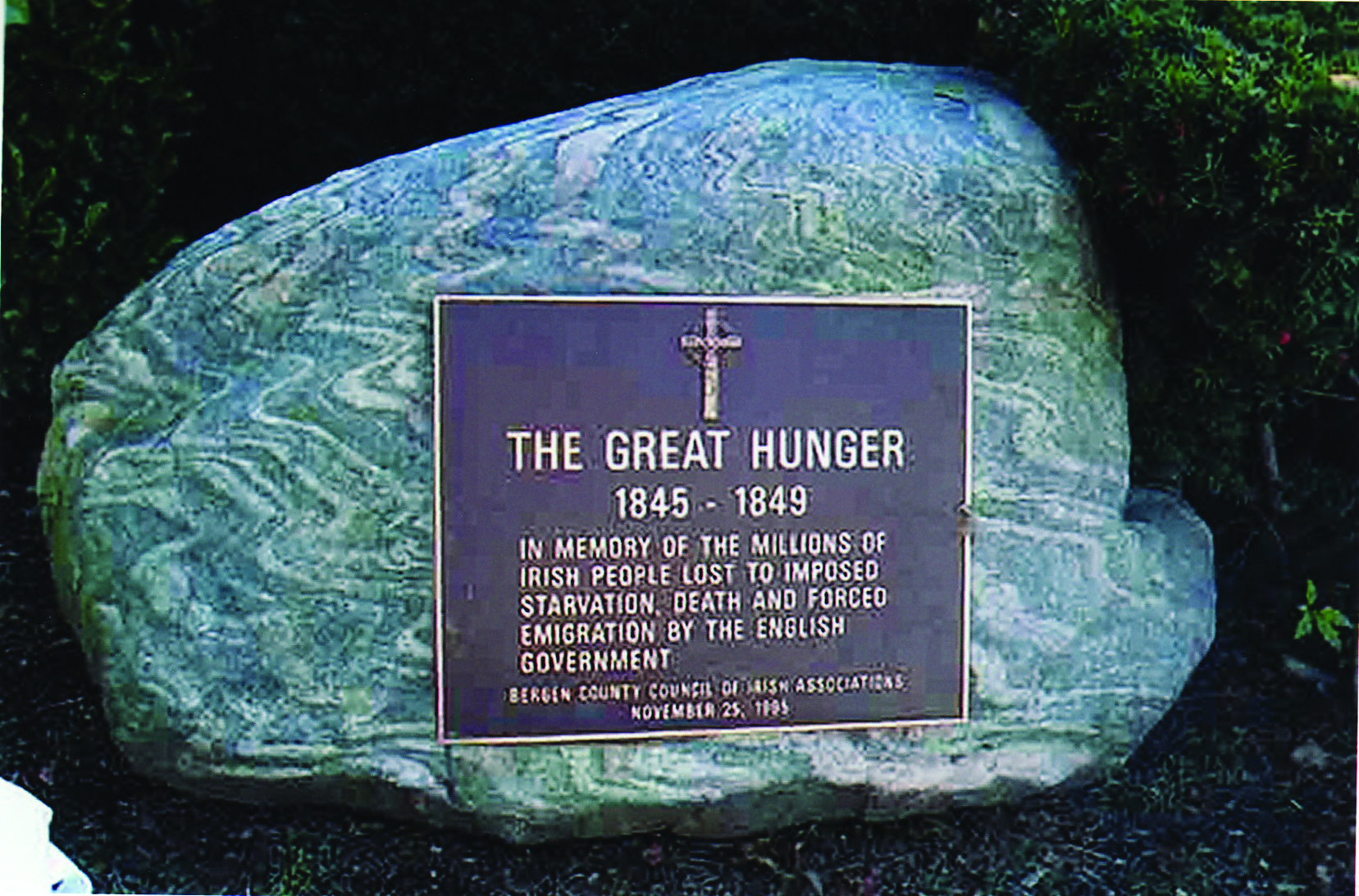
On the Court House lawn in Hackensack, Bergen County, New Jersey is a small stone with a plaque commemorating the Great Hunger. Surrounded by bushes and nearby to monuments which hold the memories of the Holocaust and the Armenian genocide, it is an understated monument part of a series on the lawn which honors the sacrifice of many ethnicities and celebrates what their descendants have contributed to the northern New Jersey communities.
Connecticut
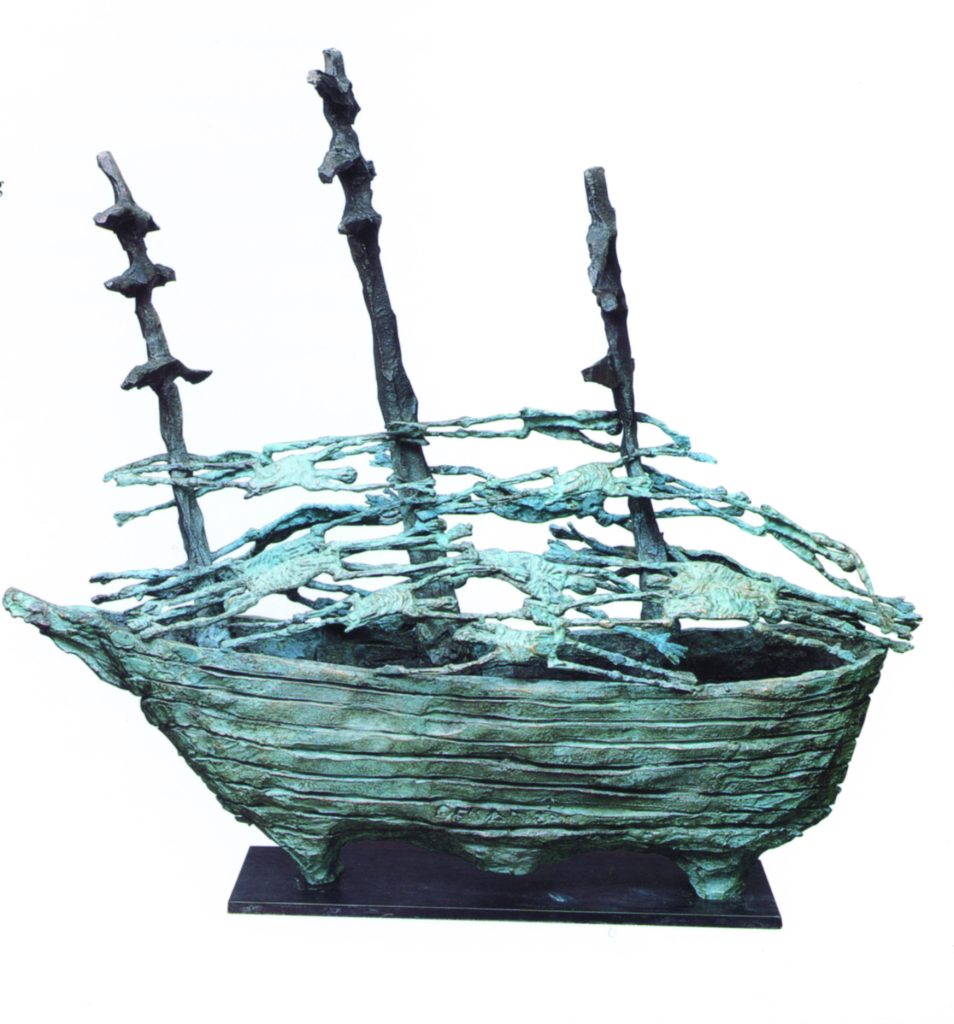
At Quinnipiac University’s library in Hamden, there is a Great Hunger room dedicated to literature, art and original documents from the time of the Famine. Located in the Lender Family Special Collection Room of the Arnold Bernhard Library, the collection explores the historical significance as well as the emotional relevance of the experiences of those who suffered.
Michigan
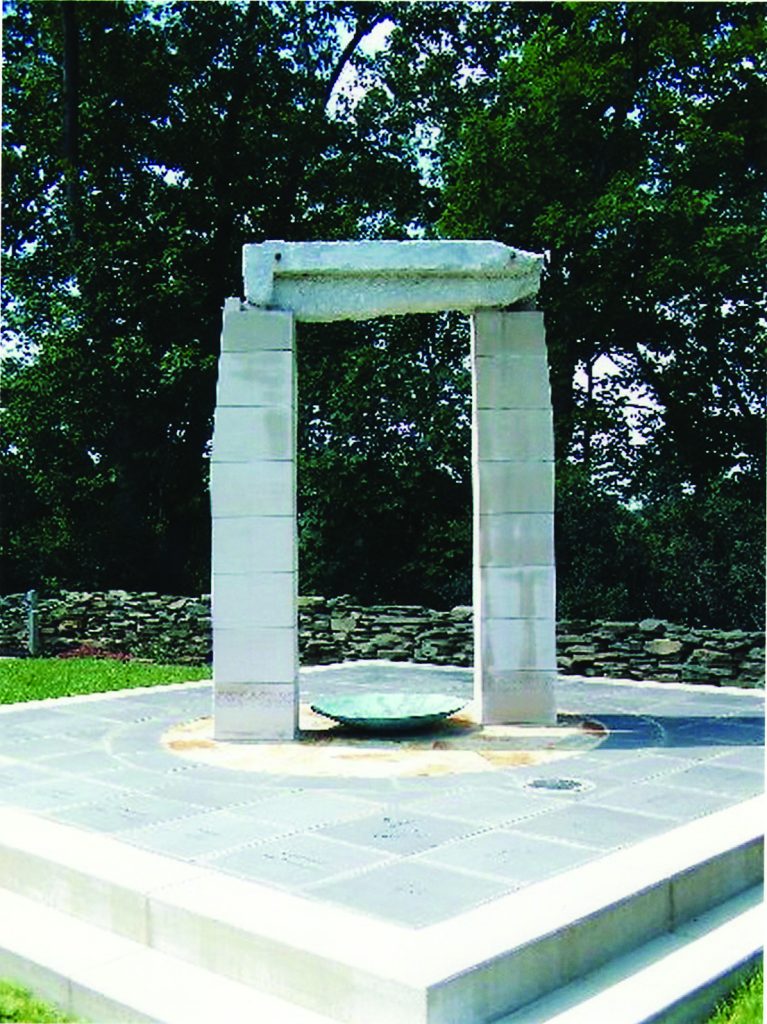
Sponsored by the Ancient Order of Hibernians, St. Patrick’s Division 1, the Michigan State Board, the Ladies AOH of Michigan and the West New York Irish Famine Memorial Committee, An Gorta Mor Memorial is a massive structure on the St. Joseph’s Shrine grounds in Brooklyn, Michigan. Two columns of eight rectangular stones support a giant stone taken from Penrose Quay, Cork Harbor, a departure point for many famine victims upon emigration. The names of the counties are written in both English and Irish on the stones which comprise the platform beneath the columns.
Pennsylvania
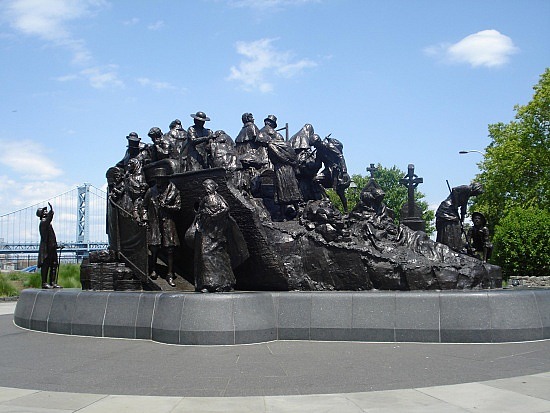
At the corner of Front and Chestnut Streets in Philadelphia, the mammoth statue dedicated to victims who found their way to the City of Brotherly Love stands at 12 feet high and 30 feet long. Featuring 35 life-sized figures, the statue which stands in a 1.75 acre park was designed by Glenna Goodacre. It depicts starvation, harrowing journeys and the will to survive.
Arizona

In the heat of America’s southwest desert city, the Phoenix Irish Cultural Center dedicated its An Gorta Mor Memorial on September 25, 1999. With a portion of a stone wall and an inscribed plaque, the words on the memorial tell of the starvation and anguish of Ireland in the mid 19th century. Located on a two-acre plot of land just south of Phoenix’s Irish Cultural Center, the memorial is joined by other structures included a replica of an Irish cottage.
Oregon

On the west coast, a 14 foot tall Celtic High Cross stands in Mount Cavalry Catholic Cemetery in Portland, Oregon. The cross is a replica piece, modeled after the ancient cross of the scriptures in Clonmacnoise, County Offaly. Brendan McGloin, an Irish sculptor, was recruited for the memorial which he carved based on the cross at Clonmacnoise, including panel scenes on the cross which depict biblical and secular scenes. The cross, carved in Donegal was shipped to Portland and dedicated by President Mary McAleese in December of 2008.
Rhode Island
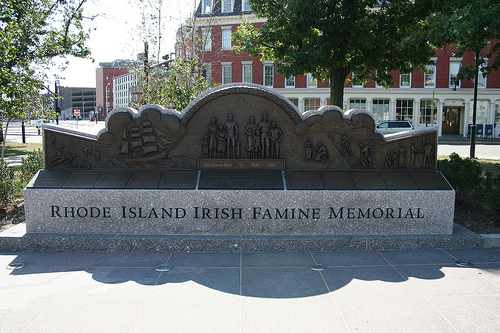
Along the Riverwolk of this homely New England city, the Providence, Rhode Island Famine Memorial was designed and created by artist Robert Shure. Its centerpiece is a large bronze statue of a man standing tall and behind him a woman holding a sickly man in her arms. The true masterpiece of this memorial is the narrative wall that Shure created alongside this statue. The wall combines images and text which tell the story of the Hunger. Dedicated in November of 2007, concerts of Irish music and heritage events are often held at the site of the memorial.
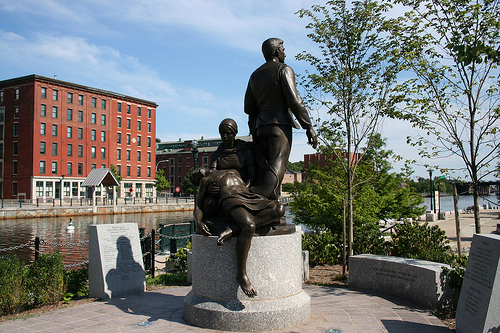
Note: There are possibly many more memorials throughout the U.S. Readers please send in additional information. There are also memorials in Ireland, the most significant being Rowan Gillespie’s Departures in Dublin’s Dockland and John Behan’s Famine Ship in Murrisk, Co. Mayo. For information on memorials in Canada read the Ghosts of Grosse Ile feature in this issue.
This article was originally published in the June / July 2010 issue of Irish America.



Leave a Reply